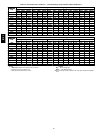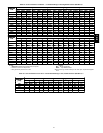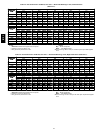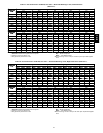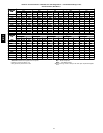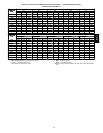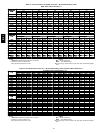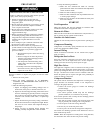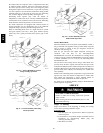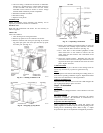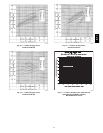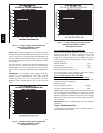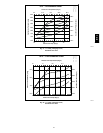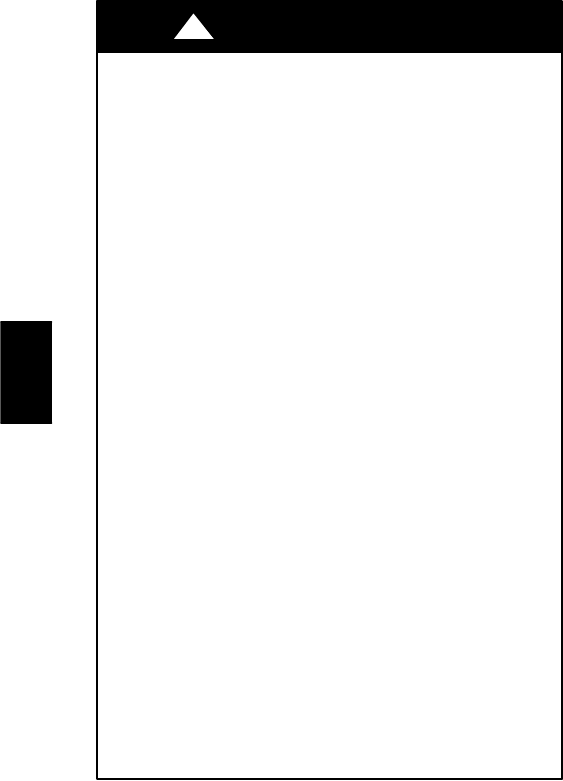
48
PRE-START-UP
FIRE, EXPLOSION, ELECTRICAL SHOCK HAZARD
Failure to follow this warning could result in personal
injury, death, and/or property damage.
1. Follow recognized safety practices and wear
protective goggles when checking or servicing a
refrigerant system.
2. Do not operate the compressor or provide any electric
power to the unit unless the compressor terminal
cover is in place and s ecured.
3. Do not remove the compressor terminal cover until
all electrical sources are disconnected and
tagged withlockout tags.
4. Relieve all pressure from the system before touching
or disturbing anything inside the terminal box if a
refrigerant leak is suspected around the compressor
terminals. Us e accepted methods to recover the
refrigerant.
5. Neve r attempt t o repair a soldered connection while
the refrigerant system is under pressure.
6. Do not use a torch to remove any component. The
system contains oil and refrigerant under pressure. To
remove a component, wear protective goggles and
proceed as follows:
a. Shut off electrical power to the unit and tag
disconnect.
b. Recover refrigerant to relieve all pressure
from the system using both high-pressure
and low-pressure ports.
c. Cut component connection tubing with a
tubing cutter, and remove the component
from the unit.
d.Carefully unsweat the remaining tubing
stubs when necessary. Oil can ignite when
exposed to a torch flame.
!
WARNING
Proceed as follows to inspect and prepare the unit f or initial
start-up:
1. Remove all access panels.
2. Read and follow instructions on all WARNING,
CAUTION, and INFORMATION labels attached to, or
shipped with, unit.
3. Make the following inspections:
a. Inspect for s hipping and handling damages such as
broken lines, loose parts, or disconnected wires, etc.
b. Inspectforoilatallrefrigerant tubingconnectionsandon
unit base. Detecting oil generally indicates a refrigerant
leak. Leak-test all refrigerant tubing connections using
electronic leak detector, halide torch, or liquid-soap
solution.
c. Inspect all field-wiring and factory-wiring connections.
Be sure thatconnectionsarecompleted and tight. Besure
that wires are not in contact with refrigerant tubing or
sharp edges.
d. Inspect coil fins. If damaged during shipping and
handling, carefully straighten fins with a fin comb.
4. Verify the following conditions:
a. Make sure that condenser-fan blade are correctly
positionedinfan orifice.SeeCondenser-FanAdjustment
section for more details.
b. Make sure that air filter(s) is in place.
c. Make sure that condensate drain trap is filled with water
to ensure proper drainage.
d. Make sure that all tools and miscellaneous loose parts
have been removed.
START-UP
Unit Preparation
Make sure that the uni t has been installed in accordance with
installation instruc tions and applicable codes.
Return--Air Filters
Make sure the correct filters are installed in the unit (See Table 1).
Do not operate the unit without return-air filters.
Outdoor--Air Inlet Screens
Outdoor-air inlet screen(s) must be in place before operating the
unit.
Compressor Mounting
Compressors are internally spring mounted. Do not loosen or
remove the compressor holddown bolts.
Internal Wiring
Check all electrical connections in unit control boxes; tighten
them as required.
Refrigerant Service Ports
Each unit system has 4 Schrader-- type service ports: one on the
suction line, one on the liquid line, and 2 on the compr essor
discharge line. Be sure that caps on the ports are tight.
High Flow Valves
Two high flow refrigerant valves are located on the hot gas tube
coming out of the compressor and the suction tubes. Large black
plastic caps distinguish these valves with O--rings located inside
the caps. No field access to these valves is availabl e at this time.
Ensure the plastic caps are in place and tight or the possibility of
refrigerant leakage could occur.
Compressor Rotation
On 3-phase units be certain that the compressor is rotating in the
proper direction. To determine whether or not compressor is
rotating in the proper direction:
1. Connect the service gauges to suction and discharge
pressure fittings.
2. Energize the compressor.
3. The suction pressure should drop and the discharge
pressure should rise, as is normal on any start-up.
If the suction pressure does not drop and the discharge pressure
does not rise to normal levels:
1. Note that the indoor fan (060 and 072 three-phase units
only) is probably also rotating in the wrong direction.
2. Turn off power to the unit and tag disconnect.
3. Reverse any two of the unit power leads.
4. Turn on power to the unit and energize the compressor.
The suction and discharge pressure levels should now move to
their normal start-up levels.
NOTE: When the compressor is rotating in the wrong direction,
the unit makes more noise and does not provide cooling.
551B,C



